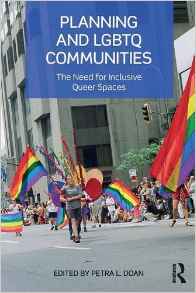Planning and LGBTQ Communities: The Need for Inclusive Queer Spaces

This volume addresses a gap in planning policy and literature regarding lesbian, gay, bisexual, transgender and queer (LGBTQ) inclusion. Some urban officials have deliberately sought to exclude the queer community by conflating its needs with those of “adult businesses”, such as in Atlanta. In many other places, there has been a (supposedly) benign neglect.
There are many parallels between inclusive queer spaces and ethnic enclaves in cities. In both cases, portions of a city are welcoming to often marginalized groups, which adds to the city’s overall diversity. And questions of gentrification, displacement and assimilation affect both types of communities; there is an ever-present tension between carving out an identity and a physical space within a city, on the one hand, and blending into the majority culture, on the other.
This is not just an issue for majority-white countries. While many of the chapters in Planning and LGBTQ Communities adopt North American case studies, the chapter “Gay Male Spatial Frames in the Developing World” points out the additional complexities when conceptualizing and planning queer spaces in urban South Africa, where sexual identity can be relatively amorphous and there may not be a spatial basis for developing a queer identity. Simply put, “gay ghettos”, “gay villages” or “gayborhoods” do not exist in South Africa to the extent they do in Canada, for example. Sexual minorities in South Africa’s cities rely more on networks than on spaces. Thus, planning in urban South Africa might be queered by focusing on virtual spaces, such as online communities, instead of physical ones. Apparently, the complexity of queer structures requires us to rethink the bounds of planning.
This chapter, like the others, highlights the diversity of the queer population. This is necessary because where urban studies have examined queerness, it has most often been through a focus on white gay men. Planning and LGBTQ Communities call for more attention to context within the wider LGBTQ grouping, such as the urban mobility exhibited by lesbians in Sydney, which has shifted in relation to lesbian-friendly day care centres, feminist bookshops, and other places. The authors of this chapter see an important role for the social dimension of planning.
How, then, can planning work toward cities in which sexual minorities and others feel safe and included? The chapters offer many practical suggestions. To give just a few:
· Mark welcoming space (e.g. flags)
· Understand urban patterns (e.g. neighbourhoods with significant queer proportions, as indicated by censuses where appropriate)
· Recognise sites important to the LGBTQ community (e.g. historical sites)
· Adopt participatory planning (e.g. citizen councils)
· Liaise between planning departments and LGBTQ groups (e.g. community outreach)
· Work with civil society to promote frameworks that promote inclusion (e.g. the Municipal Equality Index)
· Develop laws to combat exclusion (e.g. non-discrimination ordinances)
· Provide municipal support to LGBTQ community centres (e.g. funding)
· Consider levels of privilege within the queer population (e.g. people who cannot afford to live in upscale queer-friendly neighbourhoods)
Works like Planning and LGBTQ Communities are part of a broader arc in urban studies encouraging the integration of diverse groups into planning, rather than taking a one-size-fits-all approach. Whether the focus is on slum dwellers, migrants, women, ethnic minorities, or LGBTQ populations, the broadening of inclusion is welcome.
Chapter 1 available from:
Further reading:
Johnson, Linda T (2015), “Gender and sexuality I: Genderqueer geographies”, Progress in Human Geography Vol 38, No 3, pages 457–465, available at https://www.researchgate.net/publication/280494129_Gender_and_sexuality_I.
Malone, Karen (2002), “Street life: youth, culture and competing uses of space”, Environment and Urbanization Vol 14, No 1, pages 157–168, available at http://eau.sagepub.com/content/14/2/157.abstract.
Spring, Amy L (2013), “Declining Segregation of Same-Sex Partners: Evidence from Census 2000 and 2010”, Population Research and Policy Review Vol 32, No 5, pages 687–716, available at http://www.ncbi.nlm.nih.gov/pmc/articles/PMC3811952/.
Book note prepared by Christine Ro
Search the Book notes database
Our Book notes database contains details and summaries of all the publications included in Book notes since 1993 - with details on how to obtain/download.
Use the search form above, or visit the Book notes landing page for more options and latest content.
For a searchable database for papers in Environment and Urbanization, go to http://eau.sagepub.com/

